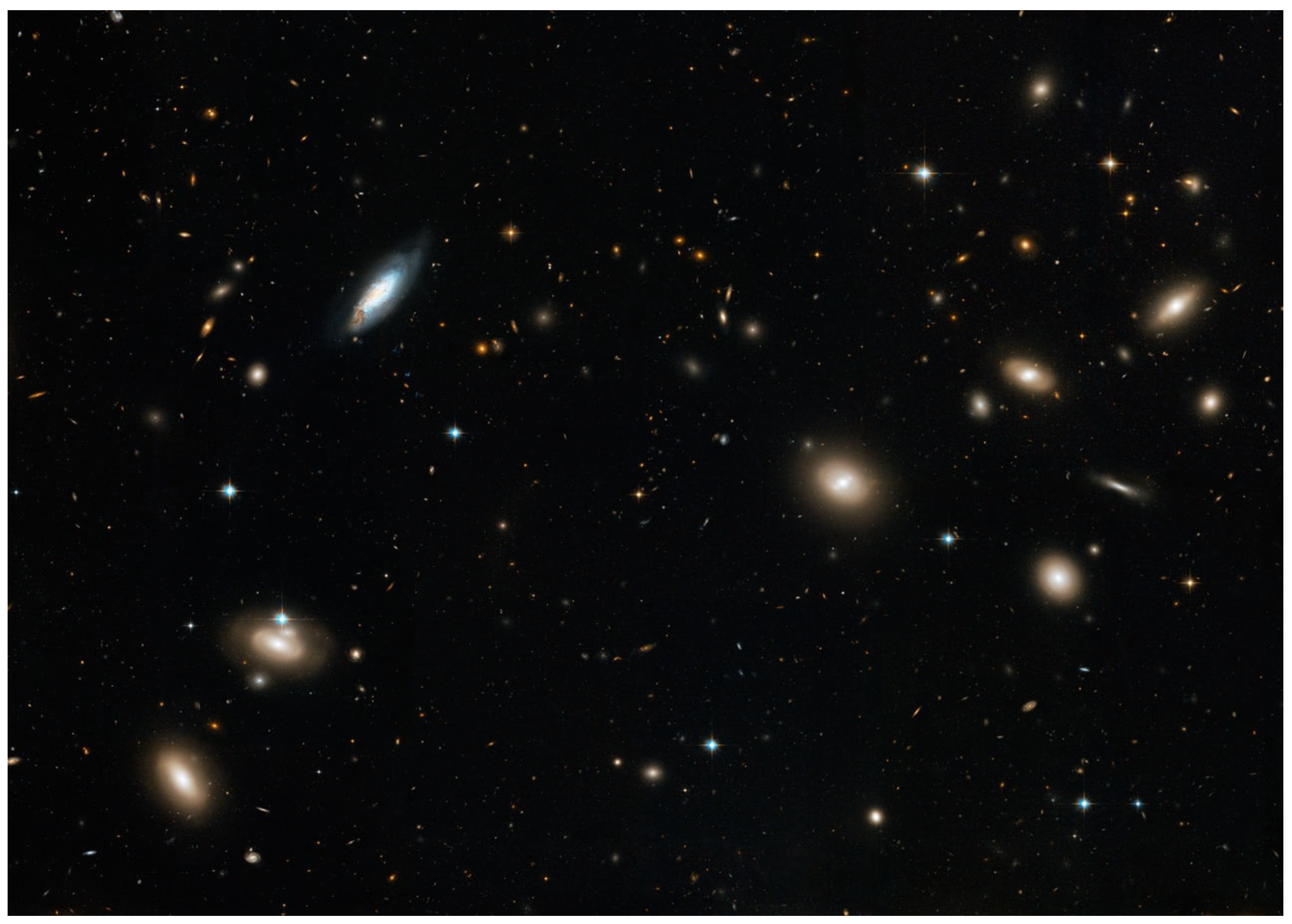Submitted:
11 June 2023
Posted:
12 June 2023
You are already at the latest version
Abstract
Keywords:
1. Introduction
2. Beyond the Newtonian Approximation
3. The Virial Theorem
4. The Virial Theorem for Retarded Gravity
5. Conclusion
References
- Yahalom, A. The effect of Retardation on Galactic Rotation Curves. J. Phys. Conf. Ser. 2019, 1239, 012006. [Google Scholar] [CrossRef]
- Yahalom, A. Retardation Effects in Electromagnetism and Gravitation. In Proceedings of the Material Technologies and Modeling the Tenth International Conference, Ariel University, Ariel, Israel, 20–24 August 2018. (arXiv:1507.02897v2). [Google Scholar]
- Yahalom, A. Dark Matter: Reality or a Relativistic Illusion? In Proceedings of Eighteenth Israeli-Russian Bi-National Workshop 2019, The Optimization of Composition, Structure and Properties of Metals, Oxides, Composites, Nano and Amorphous Materials, Ein Bokek, Israel, 17–22 February 2019.
- Wagman, M. Retardation Theory in Galaxies. Ph.D. Thesis, Senate of Ariel University, Samaria, Israel, 23 September 2019. [Google Scholar]
- Asher Yahalom "Lorentz Symmetry Group, Retardation, Intergalactic Mass Depletion and Mechanisms Leading to Galactic Rotation Curves". Symmetry 2020, 12, 1693. [CrossRef]
- Yahalom, A. Effects of Higher Order Retarded Gravity. Universe 2021, 7, 207. [Google Scholar] [CrossRef]
- A. Yahalom "The Cosmological Decrease of Galactic Density and the Induced Retarded Gravity Effect on Rotation Curves" Proceedings of IARD 2020. 2021 J. Phys.: Conf. Ser. 1956 012002.
- A. Yahalom "Effects of Higher Order Retarded Gravity on Galaxies" Proceedings of 1st Electronic Conference on the Universe. Phys. Sci. Forum 2021, 2, 26. [CrossRef]
- Michal Wagman, Lawrence P. Horwitz, and Asher Yahalom "Applying Retardation Theory to Galaxies" 2023 J. Phys.: Conf. Ser. 2482 012005. Proceedings of the 13th Biennial Conference on Classical and Quantum Relativistic Dynamics of Particles and Fields (IARD 2022), 05/06/2022 - 09/06/2022 Prague, Czechia. [CrossRef]
- R. B. Tully and J. R. Fisher, Astron. Astrophys. 54 (1977) 661.
- A. Yahalom "Tully - Fisher Relations and Retardation Theory for Galaxies" International Journal of Modern Physics D, (2021), Volume No. 30, Issue No. 14, Article No. 2142008 (8 pages). ©World Scientific Publishing Company. [CrossRef]
- Yahalom, A. Lensing Effects in Retarded Gravity. Symmetry 2021, 13, 1062. [Google Scholar] [CrossRef]
- A. Yahalom "Lensing Effects in Galactic Retarded Gravity: Why "Dark Matter" is the Same for Both Gravitational Lensing and Rotation Curves" IJMPD Vol. 31, No. A. Yahalom "Lensing Effects in Galactic Retarded Gravity: Why "Dark Matter" is the Same for Both Gravitational Lensing and Rotation Curves" IJMPD Vol. 31, No. 14, 2242018 (10 pages), received 23 May 2022, Accepted 31 August 2022, published online 30 September 2022. [CrossRef]
- Zwicky, F. On a New Cluster of Nebulae in Pisces. Proc. Natl. Acad. Sci. USA 1937, 23, 251–256. [Google Scholar] [CrossRef] [PubMed]
- Zwicky, F. 1933a, Helv. Phys. Acta 6, 110.
- Zwicky, F. 1933b, Phys. Rev. 43, 147.
- Zwicky, F. 1937, Astrophys. J. 86, 217.
- Gianfranco Bertone and Dan Hooper: History of dark matter Rev. Mod. Phys., Vol. 90, No. 4, October–December 2018 045002-4.
- Poincaré, H., and H. Vergne, 1911, Leçons sur les hypothèses cosmogoniques: professées à la Sorbonne (A. Hermann, Paris).
- Einstein, Albert (1915), "Die Feldgleichungen der Gravitation", Sitzungsberichte der Preussischen Akademie der Wissenschaften zu Berlin: 844–847. 1915.
- Tuval, M.; Yahalom, A. Newton’s Third Law in the Framework of Special Relativity. Eur. Phys. J. Plus 2014, 129, 240. [Google Scholar] [CrossRef]
- Tuval, M.; Yahalom, A. Momentum Conservation in a Relativistic Engine. Eur. Phys. J. Plus 2016, 131, 374. [Google Scholar] [CrossRef]
- Yahalom, A. Retardation in Special Relativity and the Design of a Relativistic Motor. Acta Phys. Pol. A 2017, 131, 1285–1288. [Google Scholar] [CrossRef]
- Shailendra Rajput, Asher Yahalom & Hong Qin "Lorentz Symmetry Group, Retardation and Energy Transformations in a Relativistic Engine". Symmetry 2021, 13, 420. [CrossRef]
- Rajput, Shailendra, and Asher Yahalom. 2021. "Newton’s Third Law in the Framework of Special Relativity for Charged Bodies". Symmetry 2021, 13, 1250. [CrossRef]
- Yahalom, Asher. 2022. "Newton’s Third Law in the Framework of Special Relativity for Charged Bodies Part 2: Preliminary Analysis of a Nano Relativistic Motor" Symmetry 14, no. 1: 94. [CrossRef]
- Binney, J.; Tremaine, S. Galactic Dynamics; Princeton University Press: Princeton, NJ, USA, 1987. [Google Scholar]
- Herbert Goldstein, Charles P. Poole, Jr., John L. Safko, Classical Mechanics, 3rd Edition ©2002, Pearson.
- Spitzer, L. 1969.Astrophys. J. Lett. 58, L139.

Disclaimer/Publisher’s Note: The statements, opinions and data contained in all publications are solely those of the individual author(s) and contributor(s) and not of MDPI and/or the editor(s). MDPI and/or the editor(s) disclaim responsibility for any injury to people or property resulting from any ideas, methods, instructions or products referred to in the content. |
© 2020 by the author. Licensee MDPI, Basel, Switzerland. This article is an open access article distributed under the terms and conditions of the Creative Commons Attribution (CC BY) license (https://creativecommons.org/licenses/by/4.0/).




